Accounting Project: Managing Financial Performance and Ledger
VerifiedAdded on 2021/01/02
|9
|1812
|140
Project
AI Summary
This accounting project delves into the principles of managing and monitoring financial performance, emphasizing the preparation of key financial statements, analysis of overheads, inventory records, and competitive analysis. The project extensively covers the double-entry bookkeeping system, detailing the recording of sales and purchase transactions in a general ledger, providing illustrative examples of journal entries for various financial activities, including investments, rent payments, purchases, insurance, and sales. The project also demonstrates the preparation of a statement of profit and loss and a balance sheet, culminating in the creation of a basic trial balance using the balance off rule. The assignment includes a comprehensive understanding of accounting principles and practical application through detailed ledger entries, financial statements, and the trial balance, offering a complete overview of financial accounting processes.
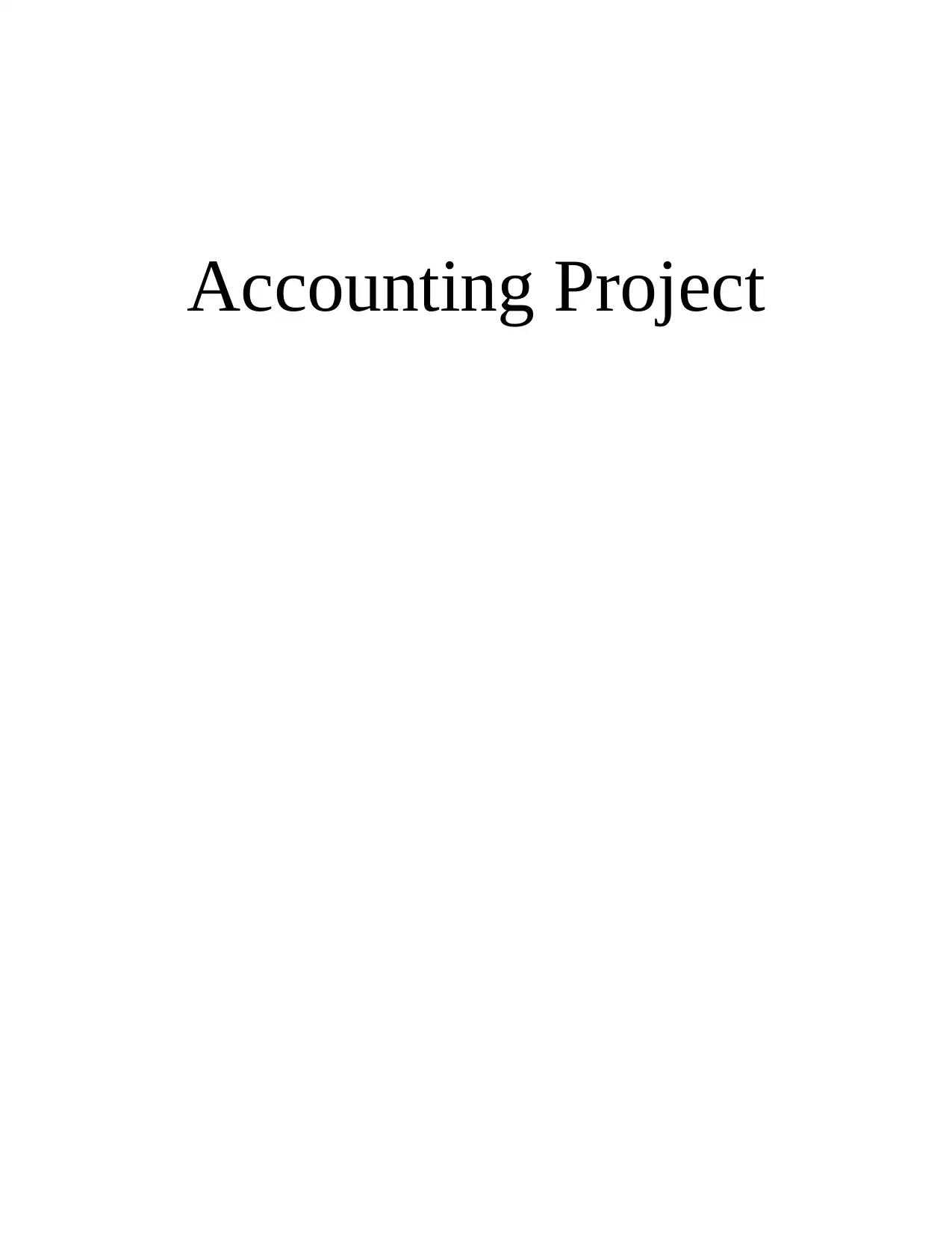
Accounting Project
Paraphrase This Document
Need a fresh take? Get an instant paraphrase of this document with our AI Paraphraser
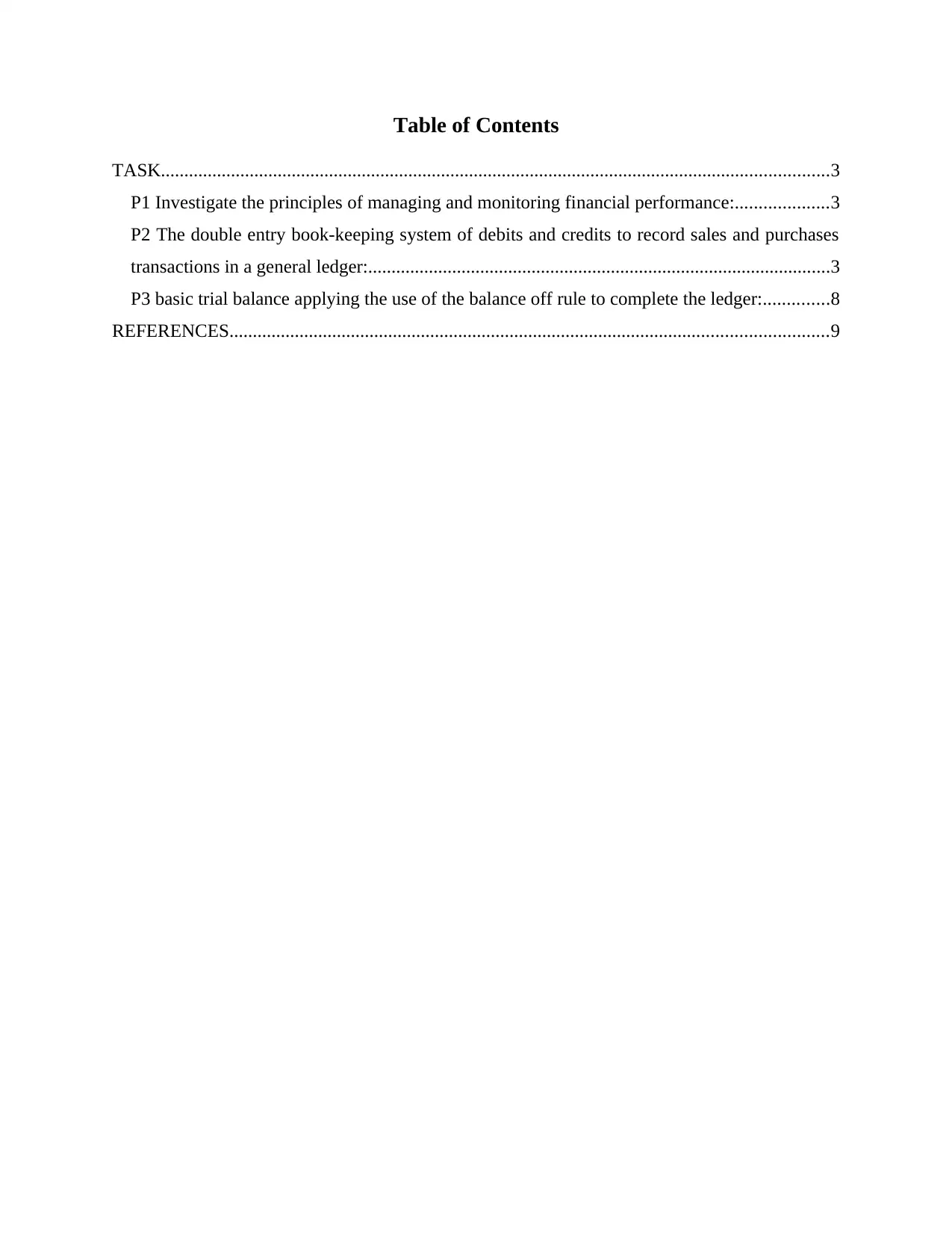
Table of Contents
TASK...............................................................................................................................................3
P1 Investigate the principles of managing and monitoring financial performance:....................3
P2 The double entry book-keeping system of debits and credits to record sales and purchases
transactions in a general ledger:...................................................................................................3
P3 basic trial balance applying the use of the balance off rule to complete the ledger:..............8
REFERENCES................................................................................................................................9
TASK...............................................................................................................................................3
P1 Investigate the principles of managing and monitoring financial performance:....................3
P2 The double entry book-keeping system of debits and credits to record sales and purchases
transactions in a general ledger:...................................................................................................3
P3 basic trial balance applying the use of the balance off rule to complete the ledger:..............8
REFERENCES................................................................................................................................9
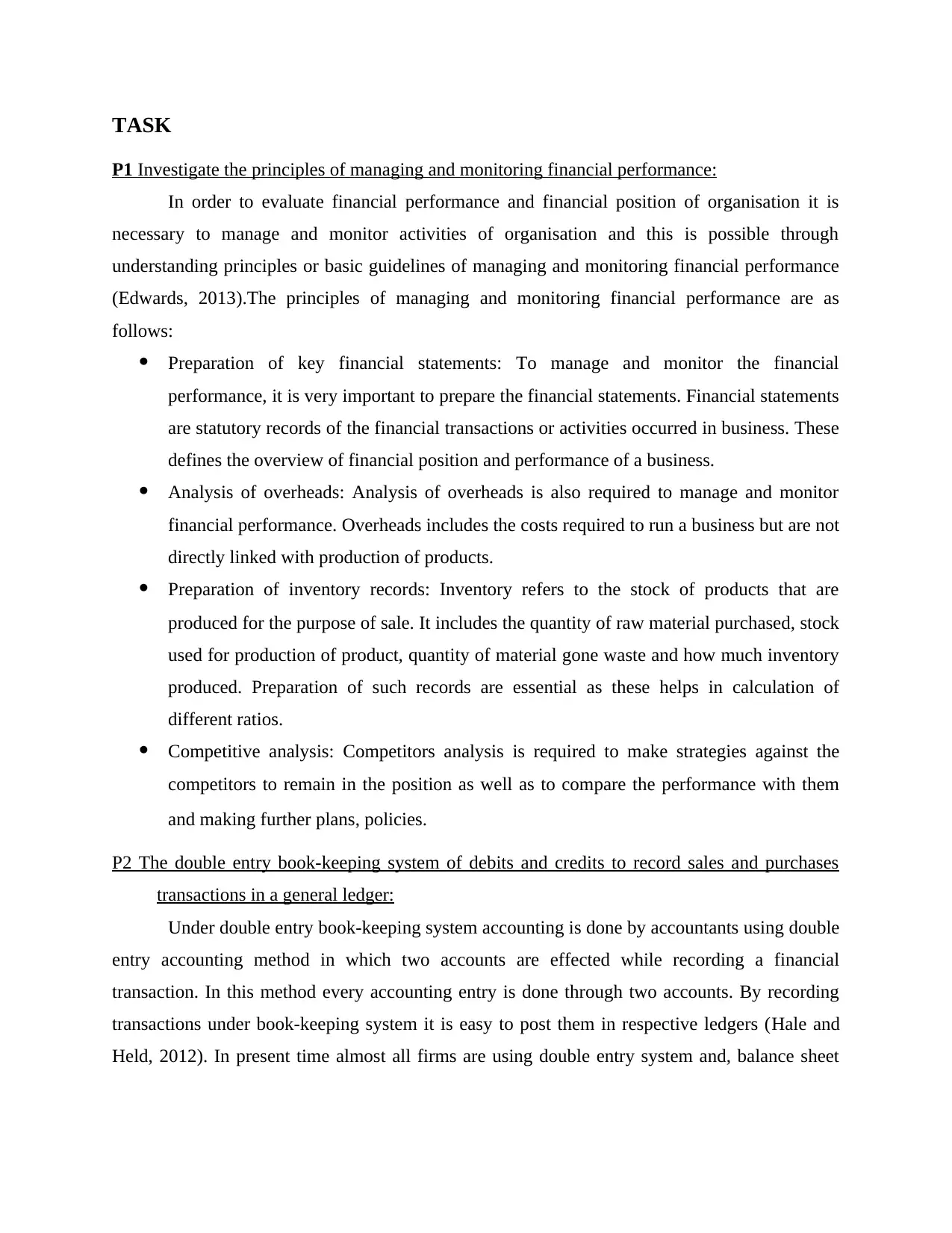
TASK
P1 Investigate the principles of managing and monitoring financial performance:
In order to evaluate financial performance and financial position of organisation it is
necessary to manage and monitor activities of organisation and this is possible through
understanding principles or basic guidelines of managing and monitoring financial performance
(Edwards, 2013).The principles of managing and monitoring financial performance are as
follows:
Preparation of key financial statements: To manage and monitor the financial
performance, it is very important to prepare the financial statements. Financial statements
are statutory records of the financial transactions or activities occurred in business. These
defines the overview of financial position and performance of a business.
Analysis of overheads: Analysis of overheads is also required to manage and monitor
financial performance. Overheads includes the costs required to run a business but are not
directly linked with production of products.
Preparation of inventory records: Inventory refers to the stock of products that are
produced for the purpose of sale. It includes the quantity of raw material purchased, stock
used for production of product, quantity of material gone waste and how much inventory
produced. Preparation of such records are essential as these helps in calculation of
different ratios.
Competitive analysis: Competitors analysis is required to make strategies against the
competitors to remain in the position as well as to compare the performance with them
and making further plans, policies.
P2 The double entry book-keeping system of debits and credits to record sales and purchases
transactions in a general ledger:
Under double entry book-keeping system accounting is done by accountants using double
entry accounting method in which two accounts are effected while recording a financial
transaction. In this method every accounting entry is done through two accounts. By recording
transactions under book-keeping system it is easy to post them in respective ledgers (Hale and
Held, 2012). In present time almost all firms are using double entry system and, balance sheet
P1 Investigate the principles of managing and monitoring financial performance:
In order to evaluate financial performance and financial position of organisation it is
necessary to manage and monitor activities of organisation and this is possible through
understanding principles or basic guidelines of managing and monitoring financial performance
(Edwards, 2013).The principles of managing and monitoring financial performance are as
follows:
Preparation of key financial statements: To manage and monitor the financial
performance, it is very important to prepare the financial statements. Financial statements
are statutory records of the financial transactions or activities occurred in business. These
defines the overview of financial position and performance of a business.
Analysis of overheads: Analysis of overheads is also required to manage and monitor
financial performance. Overheads includes the costs required to run a business but are not
directly linked with production of products.
Preparation of inventory records: Inventory refers to the stock of products that are
produced for the purpose of sale. It includes the quantity of raw material purchased, stock
used for production of product, quantity of material gone waste and how much inventory
produced. Preparation of such records are essential as these helps in calculation of
different ratios.
Competitive analysis: Competitors analysis is required to make strategies against the
competitors to remain in the position as well as to compare the performance with them
and making further plans, policies.
P2 The double entry book-keeping system of debits and credits to record sales and purchases
transactions in a general ledger:
Under double entry book-keeping system accounting is done by accountants using double
entry accounting method in which two accounts are effected while recording a financial
transaction. In this method every accounting entry is done through two accounts. By recording
transactions under book-keeping system it is easy to post them in respective ledgers (Hale and
Held, 2012). In present time almost all firms are using double entry system and, balance sheet
⊘ This is a preview!⊘
Do you want full access?
Subscribe today to unlock all pages.

Trusted by 1+ million students worldwide
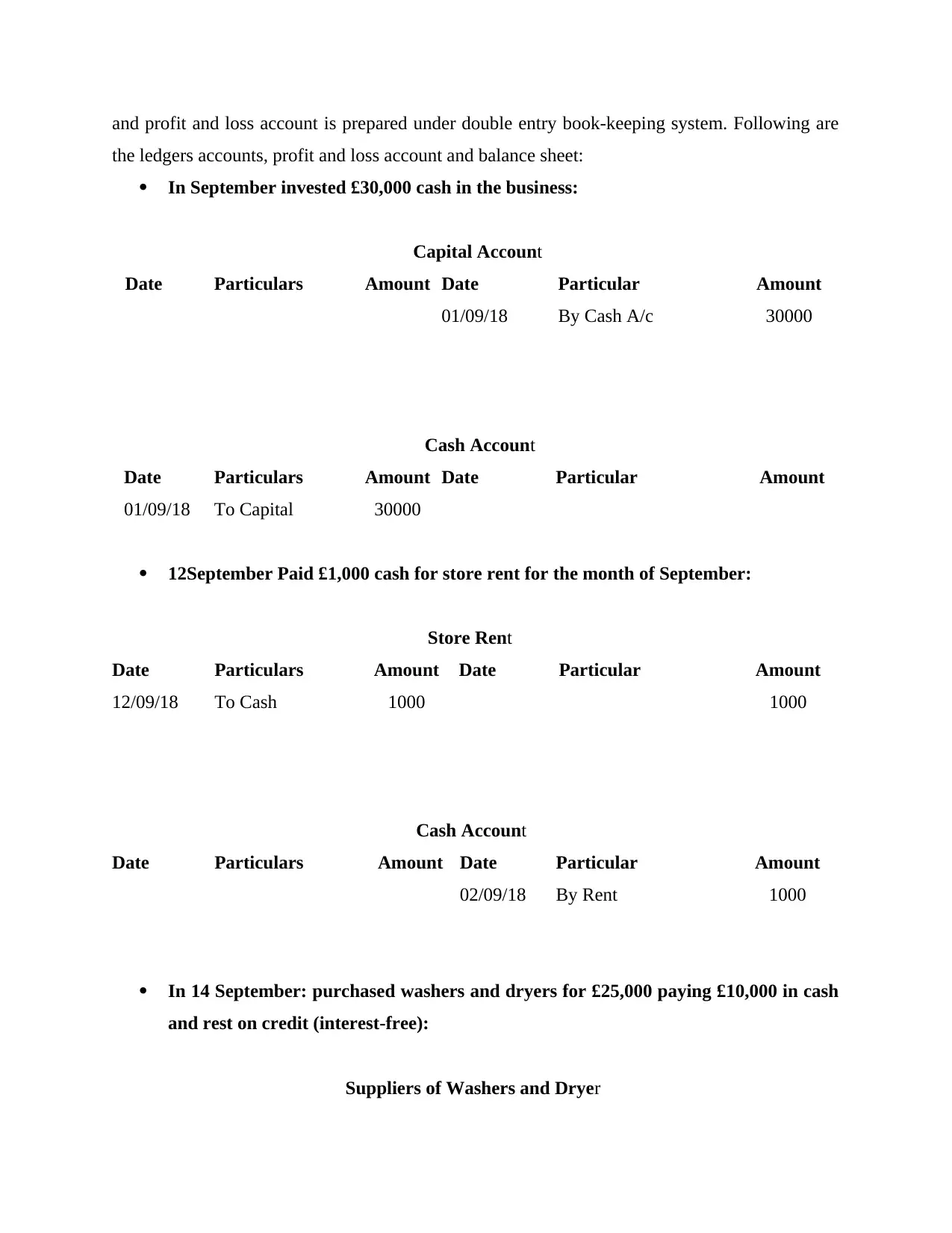
and profit and loss account is prepared under double entry book-keeping system. Following are
the ledgers accounts, profit and loss account and balance sheet:
In September invested £30,000 cash in the business:
Capital Account
Date Particulars Amount Date Particular Amount
01/09/18 By Cash A/c 30000
Cash Account
Date Particulars Amount Date Particular Amount
01/09/18 To Capital 30000
12September Paid £1,000 cash for store rent for the month of September:
Store Rent
Date Particulars Amount Date Particular Amount
12/09/18 To Cash 1000 1000
Cash Account
Date Particulars Amount Date Particular Amount
02/09/18 By Rent 1000
In 14 September: purchased washers and dryers for £25,000 paying £10,000 in cash
and rest on credit (interest-free):
Suppliers of Washers and Dryer
the ledgers accounts, profit and loss account and balance sheet:
In September invested £30,000 cash in the business:
Capital Account
Date Particulars Amount Date Particular Amount
01/09/18 By Cash A/c 30000
Cash Account
Date Particulars Amount Date Particular Amount
01/09/18 To Capital 30000
12September Paid £1,000 cash for store rent for the month of September:
Store Rent
Date Particulars Amount Date Particular Amount
12/09/18 To Cash 1000 1000
Cash Account
Date Particulars Amount Date Particular Amount
02/09/18 By Rent 1000
In 14 September: purchased washers and dryers for £25,000 paying £10,000 in cash
and rest on credit (interest-free):
Suppliers of Washers and Dryer
Paraphrase This Document
Need a fresh take? Get an instant paraphrase of this document with our AI Paraphraser
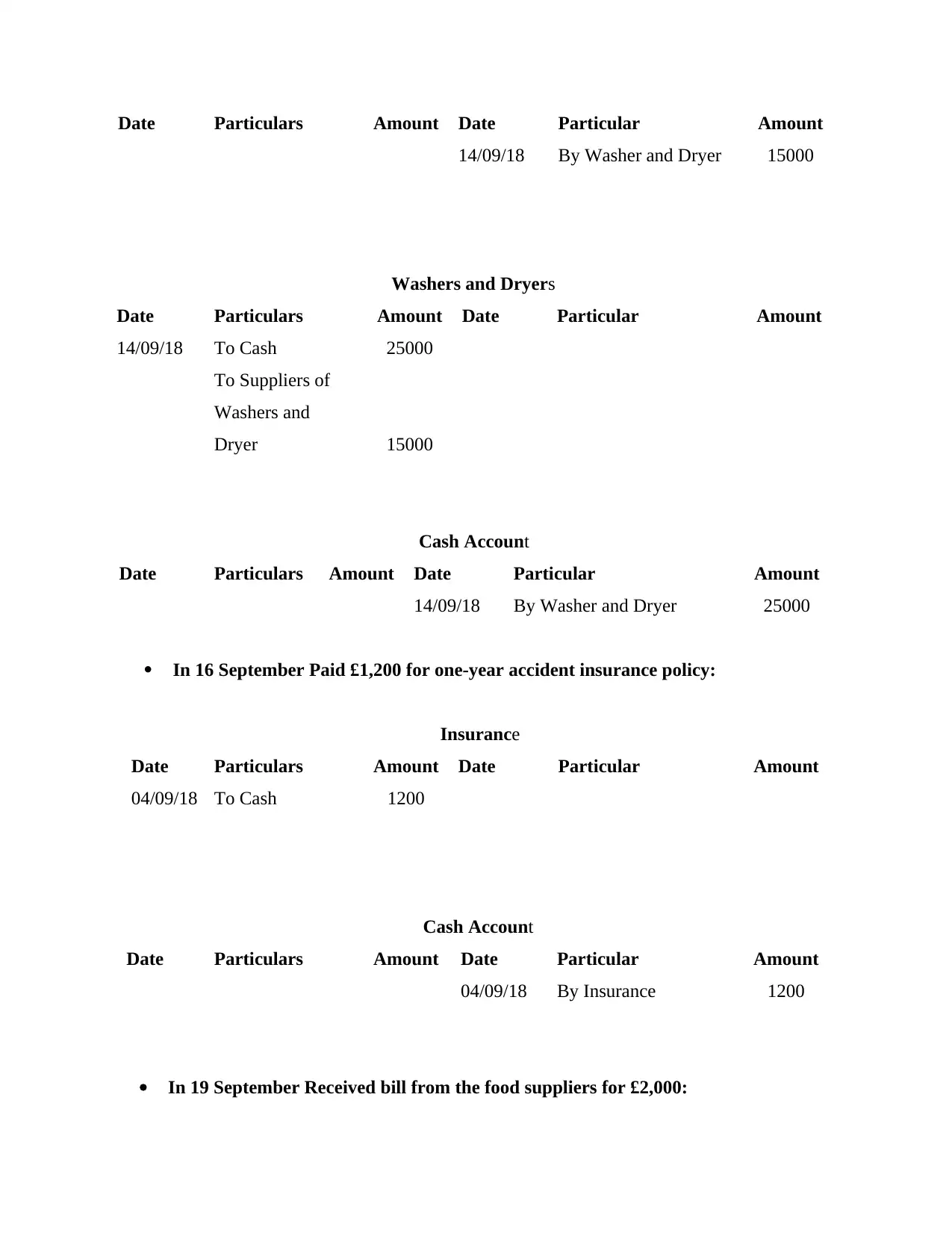
Date Particulars Amount Date Particular Amount
14/09/18 By Washer and Dryer 15000
Washers and Dryers
Date Particulars Amount Date Particular Amount
14/09/18 To Cash 25000
To Suppliers of
Washers and
Dryer 15000
Cash Account
Date Particulars Amount Date Particular Amount
14/09/18 By Washer and Dryer 25000
In 16 September Paid £1,200 for one-year accident insurance policy:
Insurance
Date Particulars Amount Date Particular Amount
04/09/18 To Cash 1200
Cash Account
Date Particulars Amount Date Particular Amount
04/09/18 By Insurance 1200
In 19 September Received bill from the food suppliers for £2,000:
14/09/18 By Washer and Dryer 15000
Washers and Dryers
Date Particulars Amount Date Particular Amount
14/09/18 To Cash 25000
To Suppliers of
Washers and
Dryer 15000
Cash Account
Date Particulars Amount Date Particular Amount
14/09/18 By Washer and Dryer 25000
In 16 September Paid £1,200 for one-year accident insurance policy:
Insurance
Date Particulars Amount Date Particular Amount
04/09/18 To Cash 1200
Cash Account
Date Particulars Amount Date Particular Amount
04/09/18 By Insurance 1200
In 19 September Received bill from the food suppliers for £2,000:
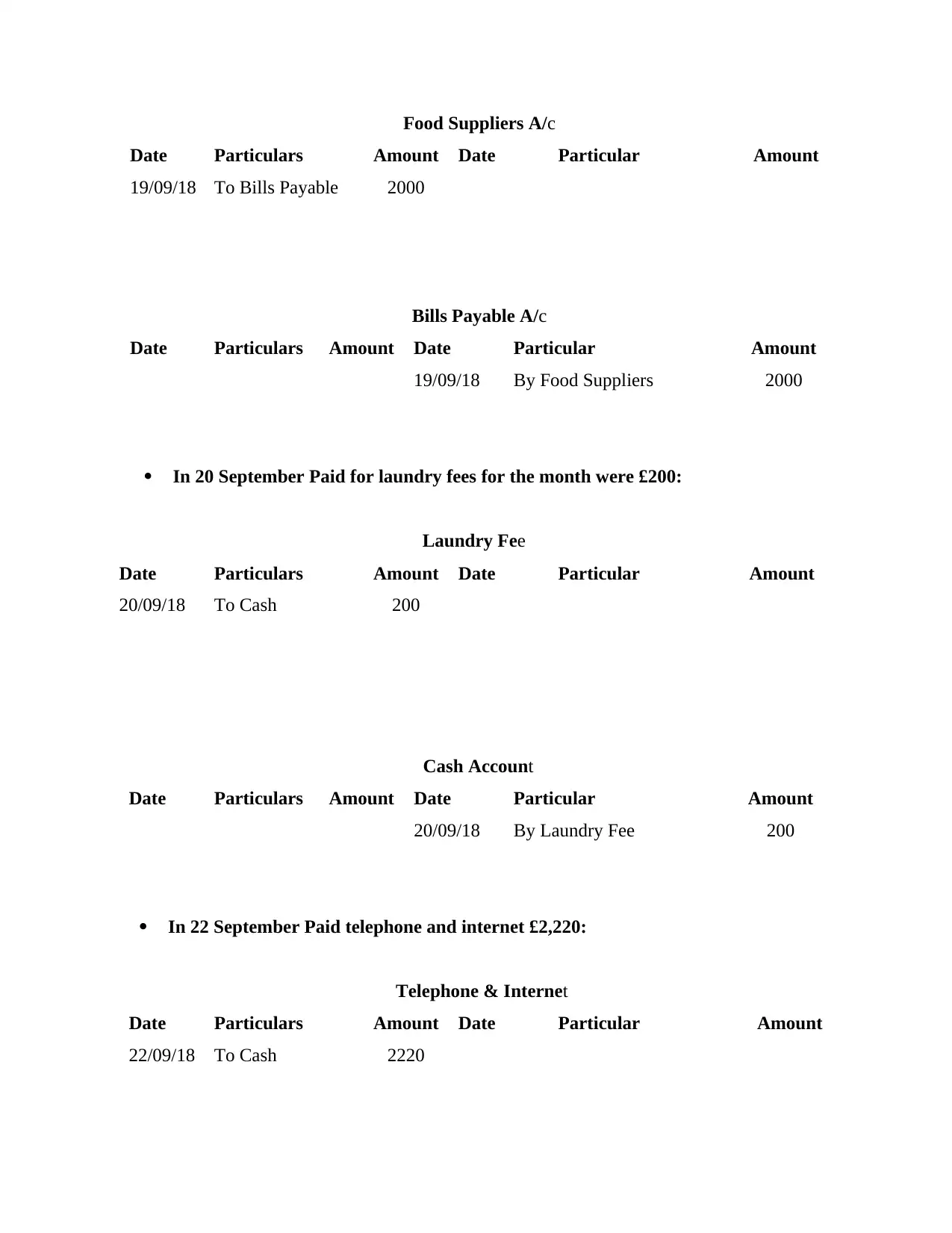
Food Suppliers A/c
Date Particulars Amount Date Particular Amount
19/09/18 To Bills Payable 2000
Bills Payable A/c
Date Particulars Amount Date Particular Amount
19/09/18 By Food Suppliers 2000
In 20 September Paid for laundry fees for the month were £200:
Laundry Fee
Date Particulars Amount Date Particular Amount
20/09/18 To Cash 200
Cash Account
Date Particulars Amount Date Particular Amount
20/09/18 By Laundry Fee 200
In 22 September Paid telephone and internet £2,220:
Telephone & Internet
Date Particulars Amount Date Particular Amount
22/09/18 To Cash 2220
Date Particulars Amount Date Particular Amount
19/09/18 To Bills Payable 2000
Bills Payable A/c
Date Particulars Amount Date Particular Amount
19/09/18 By Food Suppliers 2000
In 20 September Paid for laundry fees for the month were £200:
Laundry Fee
Date Particulars Amount Date Particular Amount
20/09/18 To Cash 200
Cash Account
Date Particulars Amount Date Particular Amount
20/09/18 By Laundry Fee 200
In 22 September Paid telephone and internet £2,220:
Telephone & Internet
Date Particulars Amount Date Particular Amount
22/09/18 To Cash 2220
⊘ This is a preview!⊘
Do you want full access?
Subscribe today to unlock all pages.

Trusted by 1+ million students worldwide
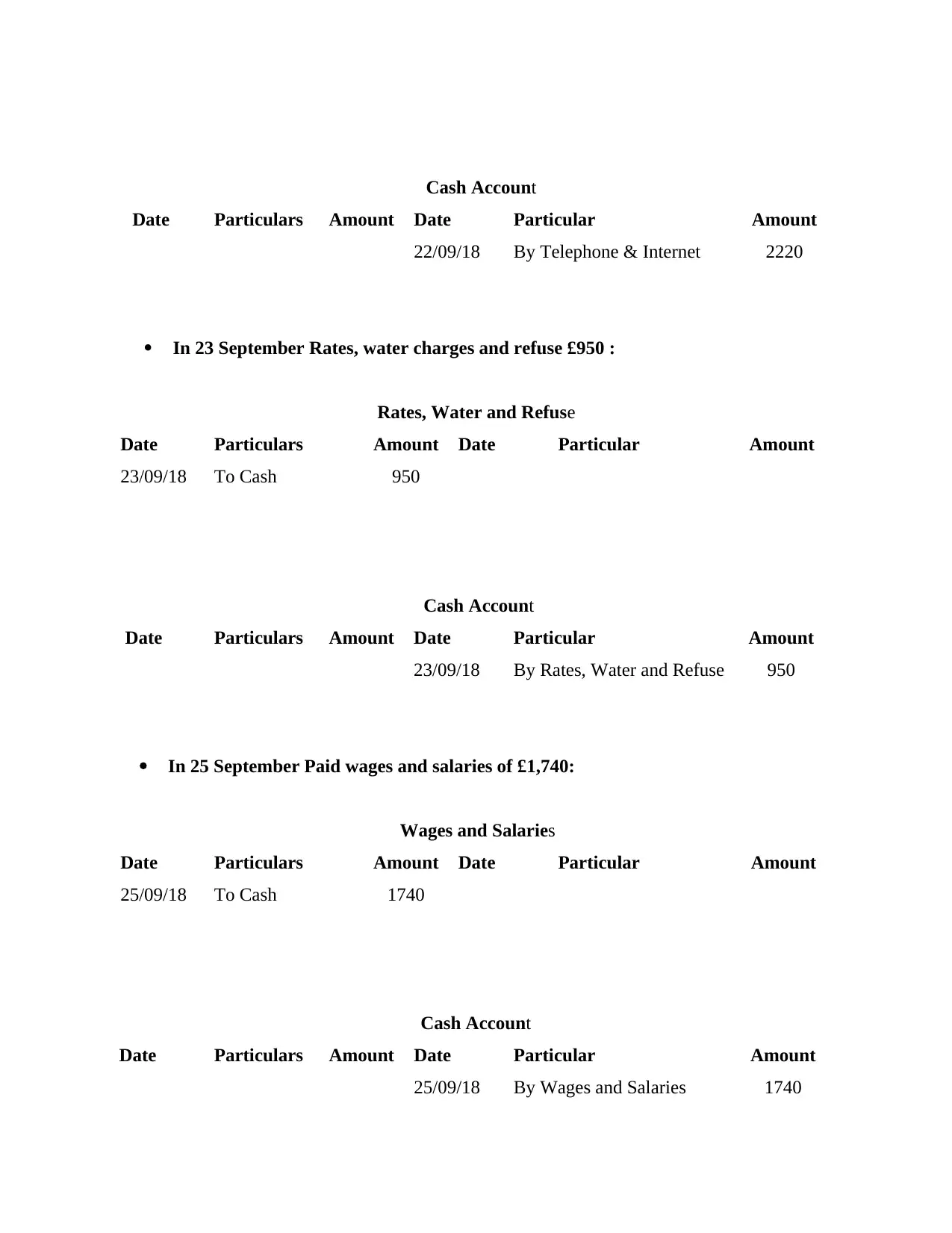
Cash Account
Date Particulars Amount Date Particular Amount
22/09/18 By Telephone & Internet 2220
In 23 September Rates, water charges and refuse £950 :
Rates, Water and Refuse
Date Particulars Amount Date Particular Amount
23/09/18 To Cash 950
Cash Account
Date Particulars Amount Date Particular Amount
23/09/18 By Rates, Water and Refuse 950
In 25 September Paid wages and salaries of £1,740:
Wages and Salaries
Date Particulars Amount Date Particular Amount
25/09/18 To Cash 1740
Cash Account
Date Particulars Amount Date Particular Amount
25/09/18 By Wages and Salaries 1740
Date Particulars Amount Date Particular Amount
22/09/18 By Telephone & Internet 2220
In 23 September Rates, water charges and refuse £950 :
Rates, Water and Refuse
Date Particulars Amount Date Particular Amount
23/09/18 To Cash 950
Cash Account
Date Particulars Amount Date Particular Amount
23/09/18 By Rates, Water and Refuse 950
In 25 September Paid wages and salaries of £1,740:
Wages and Salaries
Date Particulars Amount Date Particular Amount
25/09/18 To Cash 1740
Cash Account
Date Particulars Amount Date Particular Amount
25/09/18 By Wages and Salaries 1740
Paraphrase This Document
Need a fresh take? Get an instant paraphrase of this document with our AI Paraphraser
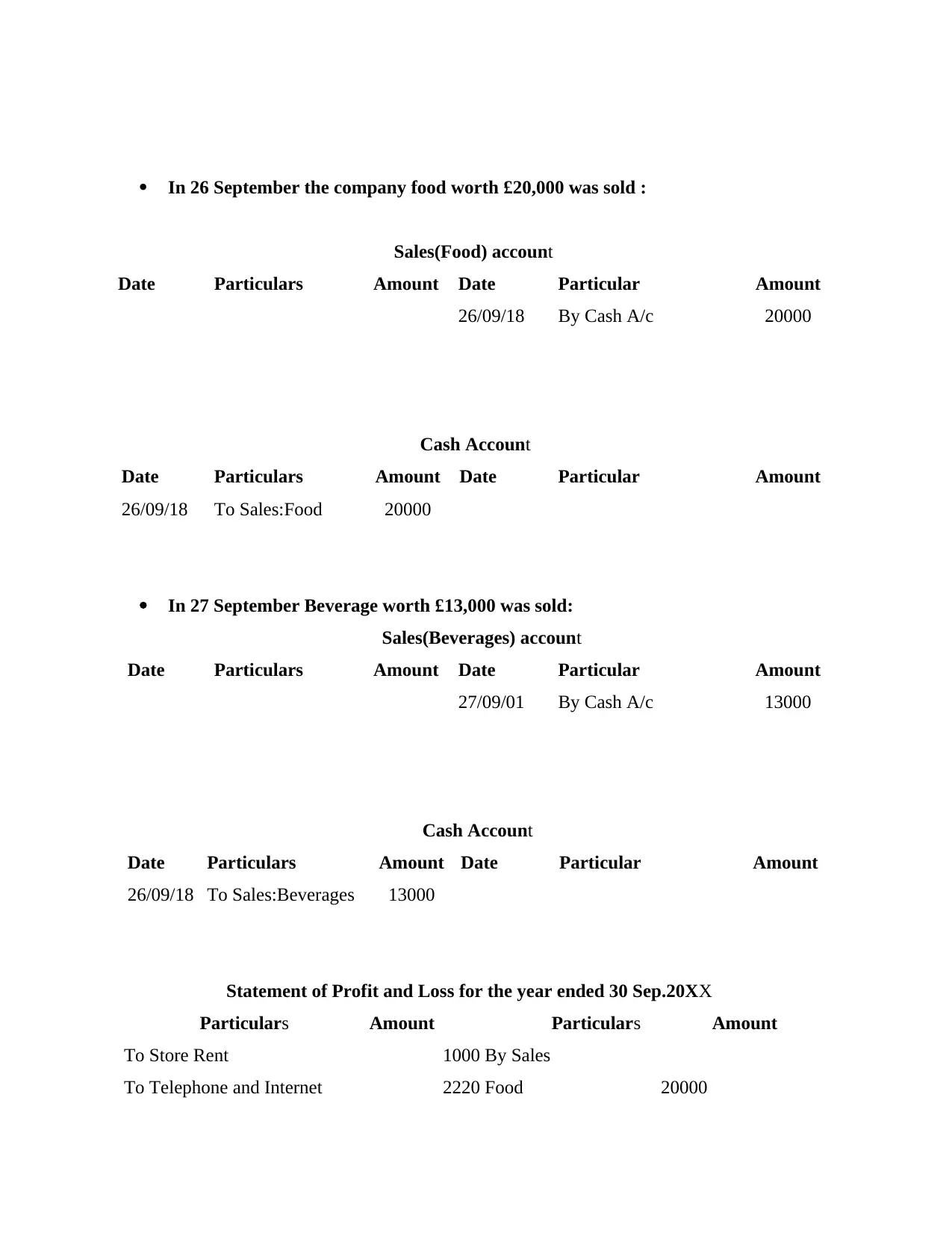
In 26 September the company food worth £20,000 was sold :
Sales(Food) account
Date Particulars Amount Date Particular Amount
26/09/18 By Cash A/c 20000
Cash Account
Date Particulars Amount Date Particular Amount
26/09/18 To Sales:Food 20000
In 27 September Beverage worth £13,000 was sold:
Sales(Beverages) account
Date Particulars Amount Date Particular Amount
27/09/01 By Cash A/c 13000
Cash Account
Date Particulars Amount Date Particular Amount
26/09/18 To Sales:Beverages 13000
Statement of Profit and Loss for the year ended 30 Sep.20XX
Particulars Amount Particulars Amount
To Store Rent 1000 By Sales
To Telephone and Internet 2220 Food 20000
Sales(Food) account
Date Particulars Amount Date Particular Amount
26/09/18 By Cash A/c 20000
Cash Account
Date Particulars Amount Date Particular Amount
26/09/18 To Sales:Food 20000
In 27 September Beverage worth £13,000 was sold:
Sales(Beverages) account
Date Particulars Amount Date Particular Amount
27/09/01 By Cash A/c 13000
Cash Account
Date Particulars Amount Date Particular Amount
26/09/18 To Sales:Beverages 13000
Statement of Profit and Loss for the year ended 30 Sep.20XX
Particulars Amount Particulars Amount
To Store Rent 1000 By Sales
To Telephone and Internet 2220 Food 20000
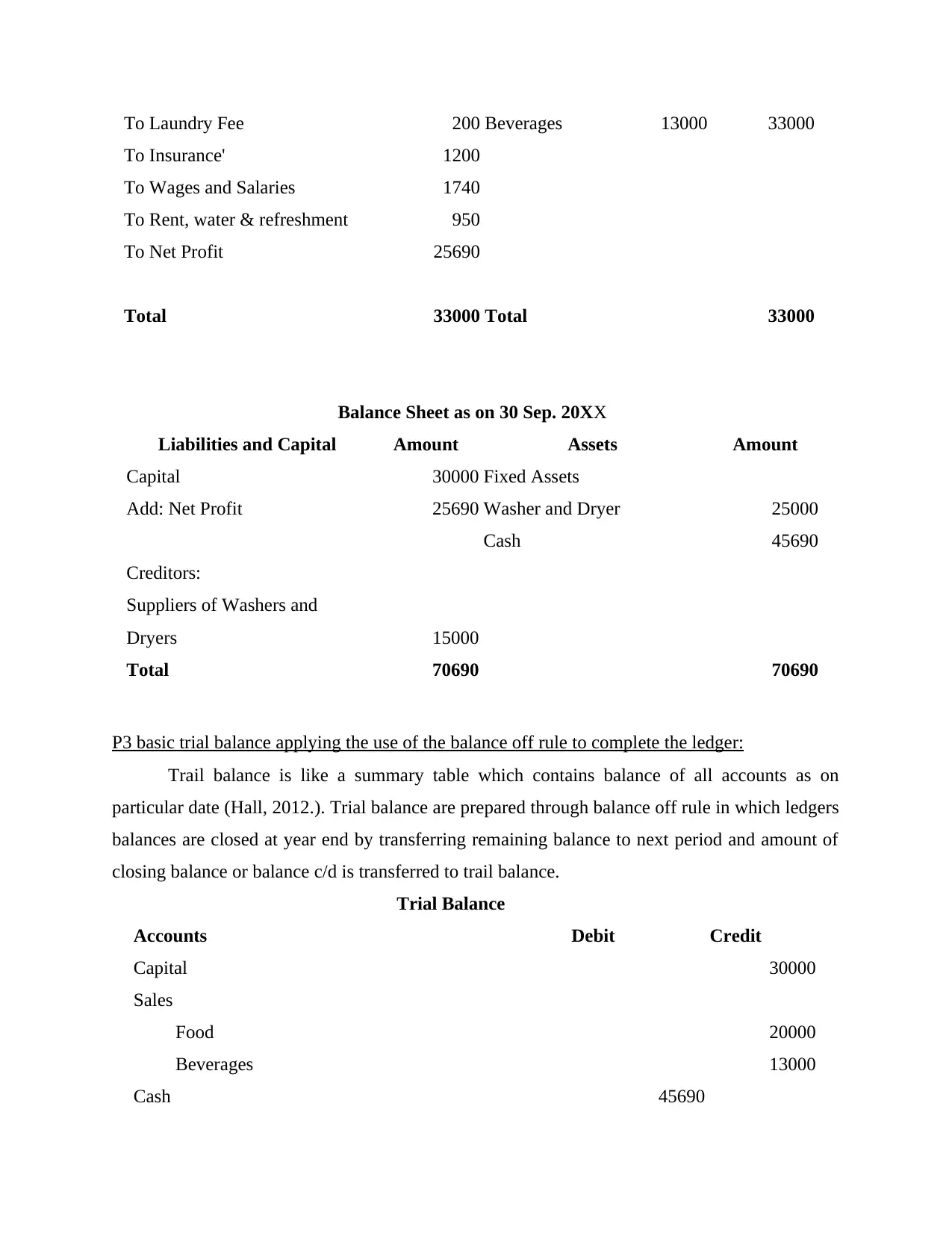
To Laundry Fee 200 Beverages 13000 33000
To Insurance' 1200
To Wages and Salaries 1740
To Rent, water & refreshment 950
To Net Profit 25690
Total 33000 Total 33000
Balance Sheet as on 30 Sep. 20XX
Liabilities and Capital Amount Assets Amount
Capital 30000 Fixed Assets
Add: Net Profit 25690 Washer and Dryer 25000
Cash 45690
Creditors:
Suppliers of Washers and
Dryers 15000
Total 70690 70690
P3 basic trial balance applying the use of the balance off rule to complete the ledger:
Trail balance is like a summary table which contains balance of all accounts as on
particular date (Hall, 2012.). Trial balance are prepared through balance off rule in which ledgers
balances are closed at year end by transferring remaining balance to next period and amount of
closing balance or balance c/d is transferred to trail balance.
Trial Balance
Accounts Debit Credit
Capital 30000
Sales
Food 20000
Beverages 13000
Cash 45690
To Insurance' 1200
To Wages and Salaries 1740
To Rent, water & refreshment 950
To Net Profit 25690
Total 33000 Total 33000
Balance Sheet as on 30 Sep. 20XX
Liabilities and Capital Amount Assets Amount
Capital 30000 Fixed Assets
Add: Net Profit 25690 Washer and Dryer 25000
Cash 45690
Creditors:
Suppliers of Washers and
Dryers 15000
Total 70690 70690
P3 basic trial balance applying the use of the balance off rule to complete the ledger:
Trail balance is like a summary table which contains balance of all accounts as on
particular date (Hall, 2012.). Trial balance are prepared through balance off rule in which ledgers
balances are closed at year end by transferring remaining balance to next period and amount of
closing balance or balance c/d is transferred to trail balance.
Trial Balance
Accounts Debit Credit
Capital 30000
Sales
Food 20000
Beverages 13000
Cash 45690
⊘ This is a preview!⊘
Do you want full access?
Subscribe today to unlock all pages.

Trusted by 1+ million students worldwide
1 out of 9
Related Documents
Your All-in-One AI-Powered Toolkit for Academic Success.
+13062052269
info@desklib.com
Available 24*7 on WhatsApp / Email
![[object Object]](/_next/static/media/star-bottom.7253800d.svg)
Unlock your academic potential
Copyright © 2020–2025 A2Z Services. All Rights Reserved. Developed and managed by ZUCOL.



